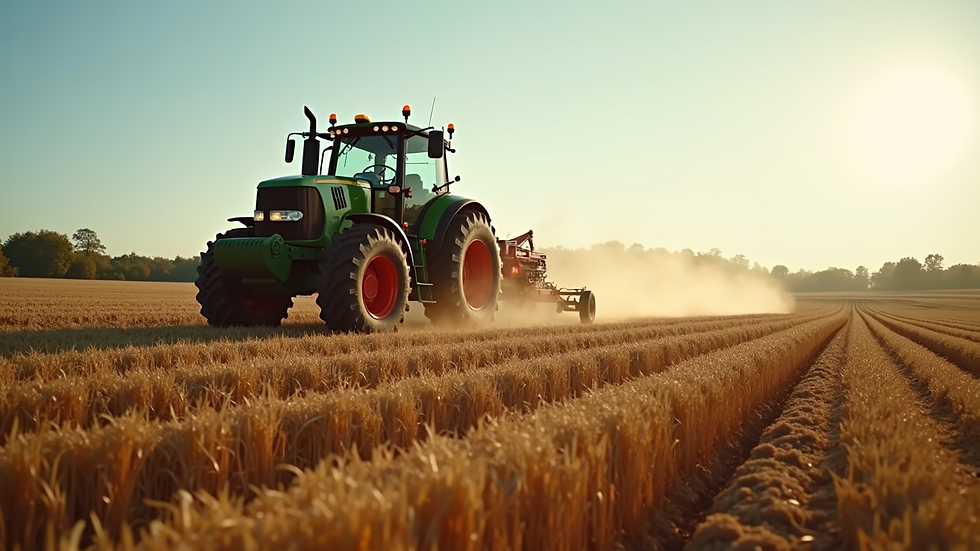Understanding the Value of a Quality Chaff Cutter
- Saroj Sharma

- May 26
- 4 min read
In the world of agriculture, efficiency and productivity are paramount. Farmers consistently seek tools that can enhance their operations, and one such invaluable asset is the chaff cutter. Often referred to as a kutti machine, this device plays a crucial role in preparing animal feed by cutting fodder into small pieces. This blog post delves into the importance of investing in a quality chaff cutter and helps you understand its price range and value.
Chaff Cutter Price
When considering the purchase of a chaff cutter, it’s essential to understand the price variance based on types, features, and brands. On average, high-quality chaff cutters can range from $200 to $1000 or more. This broad range is influenced by factors such as the machine's capacity, the material it’s made from, and the technology used.
Investing in a higher-priced chaff cutter can often lead to better efficiency and longevity. For instance, machines made from durable materials may last longer and require less maintenance, significantly reducing long-term costs. On the other hand, buying a less expensive machine may seem appealing initially but could lead to higher repair costs and lower efficiency.

In addition to the initial investment, consider the operational costs, such as energy consumption and maintenance. A quality chaff cutter may be more energy-efficient, which translates to savings in the long run. Additionally, machines with better warranties often reflect the manufacturer's confidence in their product, ensuring peace of mind as you invest.
Why Invest in a Quality Chaff Cutter?
Investing in a quality chaff cutter is more than just an expense; it’s a strategic move to enhance productivity and animal welfare. Quality chaff cutters typically offer a range of benefits:
Efficiency: A well-designed chaff cutter can slice through fodder quickly and uniformly, ensuring that animals receive the right amount of nutrients. This not only maximizes feed intake but also reduces waste.
Durability: High-quality machines are built to withstand the rigors of farming operations. They are often made from robust materials that resist wear and tear, ensuring longevity.
Versatility: A quality chaff cutter can handle different types of fodder, whether it’s grass, straw, or silage. This versatility makes it a valuable tool in any farmer's arsenal.
Health Benefits for Livestock: Properly processed fodder is easier for animals to digest. This can lead to better overall health and productivity, translating to higher milk production in dairy cattle, better weight gain in beef cattle, or improved egg production in poultry.

What is the Price of Kodubale Machine?
If you are looking for a specific type of chaff cutter, the Kodubale machine is a popular choice among farmers, especially in regions where chopped fodder is a staple in livestock diets. The price of a Kodubale machine can vary but generally falls within the range of $300 to $800, depending on its capacity and features.
Features such as electric or diesel-powered options and different cutting capacities can influence the price. Some models come with additional functionalities, like adjustable blade height or built-in shredders, which can justify a higher investment.
When shopping for a Kodubale machine, it’s advisable to compare prices from different suppliers. Factors like warranty periods and customer support can also add value to your purchase, so consider these when evaluating costs.
Selecting the Right Features
When selecting a chaff cutter, various features should be taken into account:
Capacity: Determine the volume of fodder you need to process. If you have a large farm, opt for a machine with higher throughput.
Material: The build material affects the durability of the machine. Stainless steel or heavy-duty plastic parts will generally withstand more stress and offer longer lifespan.
Drive Mechanism: Chaff cutters can be manual, electric, or machine-operated. Electric and diesel-powered options often provide more efficiency, while manual machines might be cheaper upfront but can be labor-intensive.
Ease of Use: Consider how easy it is to operate the machine. A user-friendly interface can save you time and effort, especially during peak operating seasons.
Safety Features: Ensure the machine has adequate safety mechanisms to protect users. This is particularly important if the machine is operated in a busy environment with livestock.

Understanding the Long-Term Benefits
Investing in a quality chaff cutter offers long-term benefits that extend beyond immediate savings. Studies have shown that properly processed fodder can lead to improved livestock health, which increasingly translates into better production outcomes.
Feed Conversion Efficiency: Animals that consume finely chopped fodder tend to absorb nutrients better. This can lead to improved feed conversion ratios, meaning animals gain weight faster and produce more milk or eggs within the same feed intake.
Reduced Waste: By using a quality chaff cutter, the uniformity in feed size can significantly reduce wastage. Animals often consume small, consistent pieces more readily, leading to less feed going uneaten.
Time Savings: Automation features on higher-end chaff cutters can reduce the time taken in fodder preparation, enabling farmers to focus on other vital areas of farm management.
While the initial investment in a quality chaff cutter, like the kutti machine price, can be significant, the savings in feed costs and the potential for better livestock health and productivity can make the investment worthwhile over time.
The Final Thought
The value of a quality chaff cutter cannot be overstated in today’s agricultural landscape. With ongoing advancements in technology and increasing pressures on farms to maximize productivity, selecting the right chaff cutter is fundamental. As you navigate your options, keep in mind not only the price but also the potential for productivity and health benefits that come with investing in a superior machine.
Before making a purchase, assess your farming needs, consider various factors—capacity, durability, and efficiency—and invest wisely for a prosperous future in agriculture. Making the right choice today could pave the way for a more efficient, productive tomorrow.



Comments